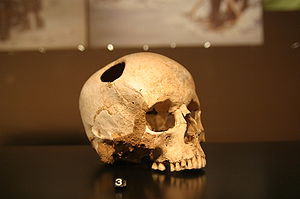Prehistoric medicine
[2] Some diseases and ailments were more common in prehistory than they are today; there is evidence that many people suffered from osteoarthritis, probably caused by the lifting of heavy objects which would have been a daily and necessary task in their societies.
Another possible explanation for the shorter life spans of prehistoric humans may be malnutrition; also, men as hunters may have sometimes received better food than the woman, who would consequently have been less resistant to disease.
[6] Plant materials (herbs and substances derived from natural sources)[10] were among the treatments for diseases in prehistoric cultures.[which?
][11] Since plant materials quickly rot under most conditions, historians are unlikely to fully understand which species were used in prehistoric medicine.
A speculative view can be obtained by researching the climate of the respective society and then checking which species continue to grow in similar conditions today[12] and through anthropological studies of existing indigenous peoples.
[23][24] There is evidence discovered of bone tissue surrounding the surgical hole partially grown back, so therefore survival of the procedure did occur at least on occasion.
[26] Medicine men (also witch-doctors, shamans) maintained the health of their tribe by gathering and distributing herbs, performing minor surgical procedures,[28] providing medical advice, and supernatural treatments such as charms, spells, and amulets to ward off evil spirits.
The medicine man then, from patients' recalling of their past and possible offenses against their religion or tribal rules, reveals the nature of the disease and how to treat it.
[citation needed] Medicine men would likely have been central figures in the tribal system, because of their medical knowledge and because they could seemingly contact the gods.
[31] Archaeologists in Mehrgarh in Balochistan province in the present day Pakistan discovered that the people of Indus Valley civilization from the early Harappan periods (c. 3300 BC) had knowledge of medicine and dentistry.
The physical anthropologist who carried out the examinations, Professor Andrea Cucina from the University of Missouri, made the discovery when he was cleaning the teeth from one of the men.
These bodies can provide scientists with subjects' (at the time of death): weight, illnesses, height, diet, age, and bone conditions,[37][circular reference] which grant vital indications of how developed prehistoric medicine was.


